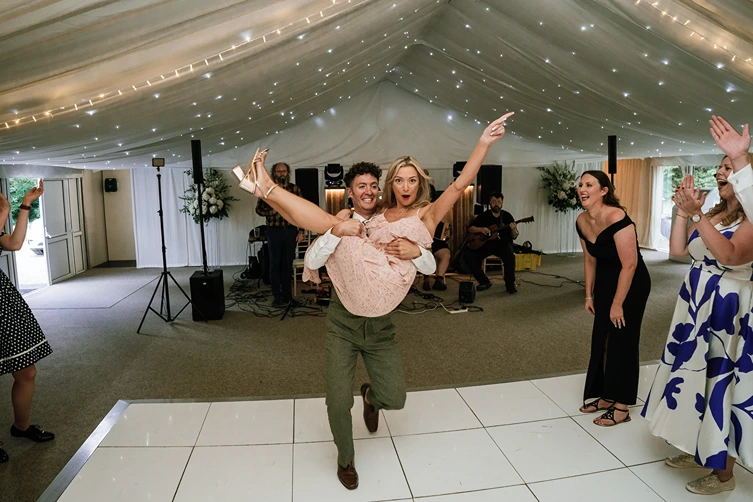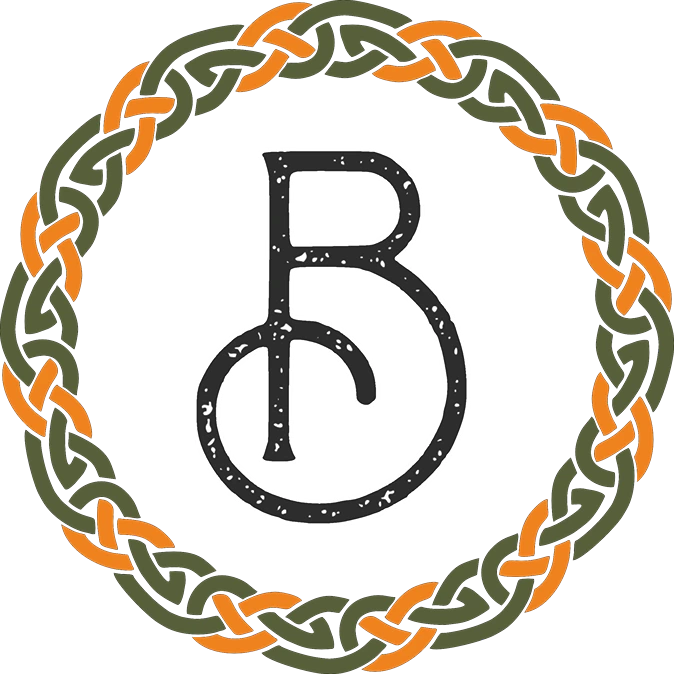From First Dance to Last Song: How to Build a Wedding Night That Flows
October 16, 2025

Why the Order of the Evening Matters
Every wedding has a rhythm. From the moment guests arrive to the last drink of the night, the flow matters. When the timing works, everything feels effortless – the speeches run smoothly, the music kicks in naturally, and the night builds to a proper celebration rather than peaking too early.
The difference between a good night and a great one isn’t about luck or budget. It’s about structure. And that’s exactly where the ceilidh-and-DJ combination shines.
Starting with Connection, Not Chaos
Most weddings hit an energy dip after the meal. People are full, the speeches are over, and they’re unsure what happens next. A ceilidh flips that completely.
The moment the caller takes the mic, the room transforms. The dances are simple enough for everyone, and within minutes the floor’s packed. It breaks down barriers instantly – no awkward waiting for “someone else to start dancing.” By the end of the first tune, everyone’s involved, laughing, and ready for more.
If you want to set the tone for the rest of the night, this is where to do it.
The Perfect Sequence
A smooth evening usually follows a simple pattern:
18:30 – Setup and Soundcheck
Your band arrives as dinner finishes. Lights, sound, and instruments go up quietly in the background so guests barely notice.
19:30 – First Dance
You can have your first dance played live or through the sound system. Either way, it works best when it flows straight into the ceilidh. It keeps the spotlight on you before shifting it naturally to the crowd.
19:35 – Ceilidh Set One (45 minutes)
The warm-up. The caller gets people moving with easy dances and a lot of laughter. It’s energetic but inclusive – the aim is to get everyone on their feet without exhausting them.
20:20 – Break (20 minutes)
Perfect for food, drinks, or catching your breath. Background music keeps the atmosphere ticking over.
20:45 – Ceilidh Set Two (45 minutes)
This is where the pace picks up. The caller brings out crowd favourites, building towards a big finish that leaves the room buzzing.
21:30 – DJ or Playlist Disco
Now that everyone’s loose and connected, you shift into full party mode. The transition’s seamless – same lights, same sound system, no silence between sets.
The Power of a Seamless Transition
When a ceilidh leads straight into a DJ set, it feels like one continuous event. There’s no dead time where energy dips or guests wander off.
Bowreed uses the same audio and lighting for both, so the swap happens in seconds. The caller wraps up the final dance, the lights shift slightly, and the first beat of the DJ set drops. The floor stays full.
That flow is the difference between a night that fades out and one that hits its stride and stays there.
Reading the Room
Every wedding crowd is different. Some love ceilidhs so much they’d dance for hours; others are itching for a mix of floor-fillers once they’ve had their dose of Scottish chaos. The trick is knowing when to change gears.
That’s why having the same person run both the ceilidh and the DJ set works so well. They’ve already read the room. They know which guests are still up for it, who’s heading for the bar, and which tunes will hit.
No awkward handovers, no “where did the energy go?” moments. Just continuity.
Choosing the Right Ceilidh Length
Not every wedding needs two full sets. Smaller gatherings often work beautifully with one 45–60 minute ceilidh followed by a DJ for the rest of the night. It depends on the space, number of guests, and how late the party runs.
The key is pacing. End the ceilidh with everyone wanting one more tune, not wishing for a chair. Then drop into the DJ set when the energy’s high, and you’ll keep people dancing for hours.
What Makes a DJ Set Work After a Ceilidh
A ceilidh warms up the crowd in a way no other entertainment can. By the time it finishes, everyone’s lost their self-consciousness. They’re already dancing, laughing, and shouting across the room.
That’s the perfect moment to hit play on a DJ set. The goal isn’t to reset the night – it’s to take that energy and carry it forward.
At Bowreed, we keep the lights on the same system so the switch is instant. Guests don’t even realise the ceilidh’s ended; they just move into the next phase of the night naturally.
The Hidden Benefit of Live-to-DJ
When couples combine a live ceilidh and DJ, they’re not just getting two services. They’re building momentum. The ceilidh bonds the guests, breaks the ice, and gives everyone a shared experience. The DJ then capitalises on that connection, keeping everyone on the floor.
It’s one of the rare setups that works across all generations. Parents join in early. Younger guests stay late. Everyone gets their moment.
And because everything runs through one setup, it’s cleaner, smoother, and more cost-effective than hiring separate acts.
What Couples Forget to Plan For
Even the best entertainment can lose impact if the schedule works against it. Here are the biggest pitfalls couples forget:
Overrunning meals – Always assume speeches will go longer than planned. Build in a small buffer.
No food break – A quick snack break between the ceilidh and DJ keeps energy up and helps guests recover.
Lighting issues – Harsh white light kills a dance floor. Make sure your venue can dim or switch to warmer tones.
Venue restrictions – Some venues limit sound levels or finish times. Always confirm the curfew and let your band know.
These small things can make or break the flow of your evening.
What Guests Remember
When guests talk about weddings afterwards, they rarely mention the food or the table settings. They talk about the dancing. The laughter. The moment they were dragged onto the floor and ended up loving it.
A ceilidh with a DJ set turns your wedding into a story people keep telling. They remember the start-to-finish flow, not a playlist that faded out while people waited for taxis.
It’s not about how many songs you play – it’s about how it feels from one moment to the next.
A Real Example
One of our favourite setups was at a barn wedding in Leicestershire. The couple started with a live ceilidh that ran for about an hour. Everyone from grandparents to uni friends got involved.
Then, as the final dance ended, the lights dimmed and the DJ kicked in. The switch was instant. The bride changed shoes, guests grabbed drinks, and within seconds the floor was full again.
By midnight, no one wanted it to end. That’s how it should feel.
Why This Format Works
A ceilidh builds connection. A DJ keeps it going. Together, they create an evening that feels structured but spontaneous. The contrast makes each part stand out – the wild group energy of the ceilidh followed by the free-flowing fun of the DJ.
You don’t need to choose between tradition and modernity. You can have both, in one seamless celebration.
Final Thoughts
If you want your wedding night to flow naturally, think about the story you’re telling. It should start with everyone together, laughing and dancing, and end with that same energy carried into the small hours.
That’s what the ceilidh-and-DJ combination delivers – connection first, celebration after.
Bowreed’s packages are built around that balance. We bring the setup, the sound, the lighting, and the experience to make it feel effortless.
Because the best nights don’t feel planned – they just happen perfectly.
